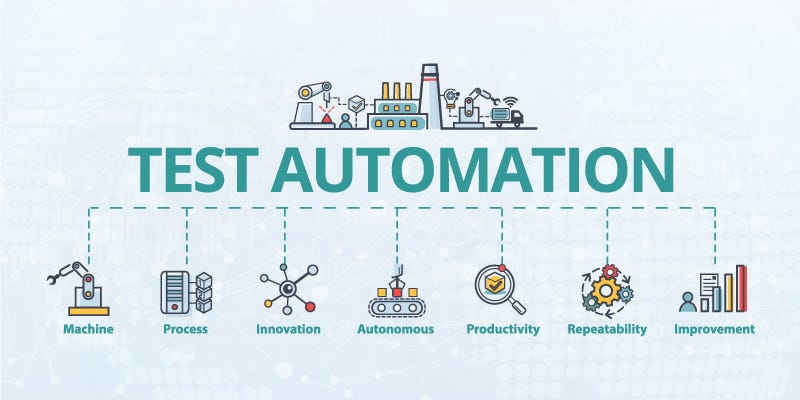Automation Testing: Secret Tips to Simplify Growth Lifecycles
Automation Testing: Secret Tips to Simplify Growth Lifecycles
Blog Article
Ensuring Success in Automation Examining: Key Metrics, Obstacles, and Solutions Every QA Group Ought To Know
In the world of software application high quality assurance, the landscape of automation testing is ever-evolving, demanding a precise approach to ensure smooth operations. Trick metrics work as the compass assisting QA teams via the substantial terrain of examination automation, clarifying progression and areas for improvement. Nevertheless, obstacles loom big, frequently casting shadows on the path to success. By recognizing these obstacles and applying effective services, QA groups can browse via intricacies with finesse. The journey to grasping automation screening is led with subtleties that require a keen eye for tracking, evaluation, and continual improvement. automation testing. As the market pushes onward, the mission for optimal efficiency in automation screening continues to be a constant quest, advising QA groups to equip themselves with the understanding and strategies crucial for victory.
Significance of Secret Metrics
Recognizing the significance of vital metrics is essential for evaluating the performance and effectiveness of automation screening procedures. Trick metrics work as measurable procedures that supply useful understandings right into various facets of the screening procedure, such as examination coverage, test execution time, defect thickness, and test case performance. By examining these metrics, QA teams can recognize bottlenecks, inadequacies, and areas for renovation within their automation testing structure.
One important element of vital metrics is their ability to track progression and check the overall health of the testing process (automation testing). They enable stakeholders to make informed decisions based upon data-driven understandings, which can lead to a lot more efficient testing approaches and better source allocation. Furthermore, vital metrics can help groups established realistic goals, gauge the success of automation initiatives, and show the ROI of automation screening efforts

Usual Obstacles Encountered
Difficulties typically experienced in automation testing processes can significantly influence the total efficiency and effectiveness of QA groups. One of the major obstacles is the choice of the best examination instances for automation. Not all examination situations are suitable for automation, and picking the incorrect ones can result in lost time and resources. Furthermore, maintaining examination manuscripts can be an overwhelming job, specifically as the application undertakes constant modifications. Test manuscript maintenance calls for constant updates and modifications to guarantee they reflect the existing performance precisely. An additional typical challenge is the first financial investment required for setting up automation structures and devices. This can be a barrier for some companies, particularly smaller sized ones with restricted budget plans. Additionally, automation testing may not cover all elements of screening, such as functionality and customer experience testing, which still call for manual treatment. Overcoming these challenges needs correct preparation, tactical examination instance option, durable maintenance processes, appropriate resources, and a clear understanding of the constraints of automation testing.
Reliable Solutions for Obstacles
To deal with the obstacles experienced in automation testing, implementing reliable remedies is crucial for enhancing the efficiency and productivity of QA groups. One essential service is to purchase robust training programs for QA groups to ensure they have the necessary abilities to successfully use automation tools. Training can link understanding gaps, boost understanding of automation frameworks, and enhance scripting capacities, eventually leading to extra effective test development and execution.
An additional important solution is to develop clear communication networks within the QA team and with various other stakeholders, such as developers and job managers. Reliable communication aids in aligning assumptions, sharing progress updates, and immediately dealing with concerns or obstructions that might occur throughout the automation testing process.

Surveillance and Analysis Techniques
Carrying out effective tracking and evaluation techniques is critical for making here are the findings sure the success and efficiency of automation screening processes. Furthermore, analyzing examination outcomes and metrics offers useful insights into the top quality of the software application being examined and the effectiveness of the testing approach.
One secret technique in tracking and evaluation is making use of dashboards that combine pertinent metrics and KPIs in a visually easily accessible format. These dashboards use a comprehensive introduction of examination execution standing, test protection, flaw trends, and other important details. Regularly examining and assessing these control panels can aid QA teams make informed decisions, focus on jobs, and maximize screening initiatives.
In addition, implementing automated alerts and notifications based on predefined thresholds can improve positive surveillance and prompt treatment. By establishing signals for efficiency deviations or examination failings, groups can resolve concerns without delay and stop them from escalating. Overall, monitoring and evaluation strategies play a vital duty in ensuring the effectiveness and success of automation screening campaigns.
Continual Improvement Approaches
Enhancing the efficacy of automation screening processes requires the consistent refinement of methodologies and methods. One vital technique to boosting automation testing procedures her comment is here is to conduct routine testimonials and retrospectives.

Verdict
To conclude, it is essential for QA groups to comprehend the essential metrics, obstacles, and options in automation screening to make certain success. By meticulously keeping an eye on and evaluating information, carrying out effective remedies to typical obstacles, and constantly improving methods, QA teams can maximize their testing procedures and provide high-quality software application products. Following these practices will eventually lead to a lot more effective and effective automation screening practices.
By assessing these metrics, QA teams can determine traffic jams, inefficiencies, and locations for improvement within their automation testing structure.
Additionally, essential metrics can aid teams set sensible objectives, determine the success of automation Check Out Your URL initiatives, and demonstrate the ROI of automation testing efforts.
Difficulties generally experienced in automation screening procedures can dramatically affect the overall efficiency and performance of QA groups. Automation testing might not cover all facets of testing, such as usability and user experience testing, which still need manual intervention.In final thought, it is critical for QA groups to understand the key metrics, challenges, and services in automation testing to guarantee success.
Report this page